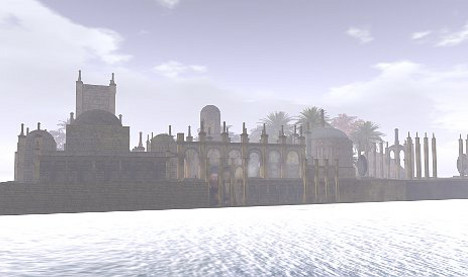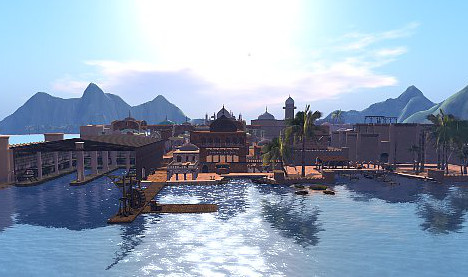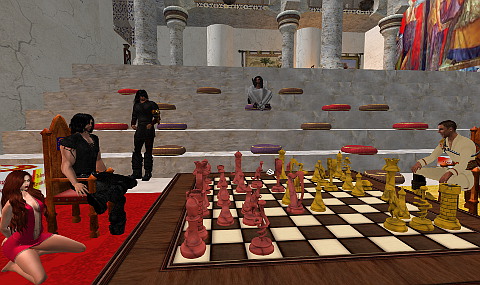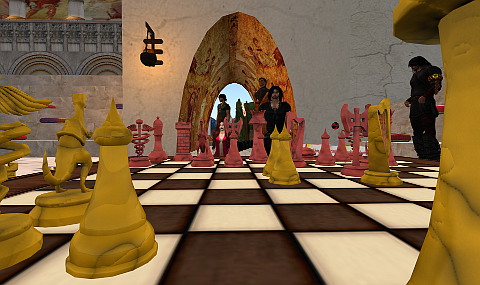Kaissa Tournament in Ianda
Playing: DarkFire, Ambassador of the Kaissa Guild of Gor, versus Kjerulf, caste of players. Darkfire won.
1) Introduction: what is the Kaissa?
Kaissa is the Gorean word for “game”. It is a general term that can refer to any type of game but when it is used without qualification, it means only one game, Gorean chess. This is a game very similar to Earth chess though there are numerous differences as well. Kaissa is a very popular game and almost all civilized Goreans, of whatever caste, play. There are many Kaissa clubs and competitions. Lists of important competitions and tournaments are commonly kept in each city’s Cylinder of Documents. Most city libraries have many scrolls of Kaissa strategy and techniques.
Kaissa uses a red and yellow hundred-squared board, with ten ranks and ten files. This is opposed to the normal Earth chessboard of sixty-four squares with eight ranks and files. In Kaissa, there are twenty-two pieces to each side as opposed to sixteen in Earth chess. One side is yellow and the other is red.
Kaissa is played differently throughout Gor. Some cities use different pieces or similar pieces with different abilities. Eventually most cities accepted standard tournament rules, helping to unify and standardize play. These rules were agreed upon by the High Council of the Caste of Players and officially promulgated by the Merchant Caste in 10124 C.A. at the En’Kara fair. Standardized Kaissa may also be known as Merchant Kaissa, Player Kaissa or Kaissa of the En’Kara. Unfortunately, though much information is given about the game, the novels do not provide a complete set of rules for playing Kaissa.
In Torvaldsland, they play their own version of Kaissa. They have a great passion for the game, even greater than those in the south. They sometimes settle disputes over the Kaissa board rather than with weapons. Some pieces differ in their game. The Jarl, their most powerful piece and the Jarl’s Woman, more powerful than the Ubara, are used instead of an Ubar and Ubara. Instead of Tarnsmen there are two Axes. They have no Initiates but have Rune-Priests. They do not have Scribes but have a piece, the Singer, which moves similarly. Their Spearmen move identically as in the southern game. Instead of a Home Stone, there is a Lodge.
Slaves are not commonly permitted to play Kaissa. It is even illegal in some cities for slaves to play or even touch the pieces without permission. They could lose their hands or even be killed for such a violation. Free women also seem not to play Kaissa though there is no explicit prohibition in the books stating that they may not play. Assassin of Gor does make a brief reference that women do not play the game.
2) Southern version: the pieces
Ubar:
The Ubar is the most powerful piece on the board, and is situated on the back row. It can move, on the board, as far as the Player likes in any direction, so long as its way is not impeded by another piece.
Its loss does not constitute the end of the game, this only happens when the Homestone is taken.
Ubara:
The Ubara, situated on the back row on a square of her own colour, moves almost the same way as the Ubar, except for the fact that it is restricted to three squares in any direction, as long as it is not impeded by another piece in its way.
Tarnsman:
The Tarnsman, of which there are two, is another back row piece, and is the Ubar’s most probable right hand man. Its moves are three squares up and two over in any direction. These moves allow the Tarnsman to go over or around another piece, and to capture any piece belonging to an opponent.
The Tarnsman can also move one square in any direction, these moves do not allow it to capture any other piece.
Scribe:
The Scribe, two to each side, sit on the back row. It moves diagonally on its own colour in both directions, but is limited to five squares, as long as no one impedes its progress.
Builder:
The Builder, two per player, is another back row piece. It moves forward, backward and laterally in both directions, with no limit to the number of squares, so long as no one impedes its progress.
Initiate:
The Initiate is one of two pieces per player on the back row. It too, like the Scribe, moves diagonally, but has no limits to how many squares he can move, so long as its way is not impeded by another piece.
Spearman:
The Spearman is one of six each side, and is the main front row piece. It moves forward only and captures only on the diagonal. On the first move, the Spearman has the option of moving either one, two or three squares forward. After the Spearman’s first move it advances only one square at a time. A Spearman can be redeemed for another piece, either the Rider of the High Tharlarion or the Tarnsman: this happens when it has reached the opponent Player’s first rank and can move no further forward.
Rider of the High Tharlarion:
The Rider of the High Tharlarion is one of two pieces per player, and it flanks the six Spearmen on the front row. The Riders can move one square in any direction, as long as they are not impeded by another piece.
Assassin:
The Assassin, two per player, flank the two Riders of the High Tharlarion on the front row. The Assassins can move two squares in any direction forward, backward, laterally or diagonally, so long as they are not impeded by another piece.
Homestone:
The Homestone is the most important piece of the game. It does not start on the board, but each Player must place it on the board by the tenth move. The placement of the Homestone constitutes a movement on its own. If the Homestone isn’t placed on or before the tenth move, the game is over and the other Player will win the match. The aim of the game is to take your opponent’s Homestone without losing your own. The game is over when one or the other Homestone is taken, or one Player resigns, or a draw is accepted. The Homestone has the ability to move one square in any unimpeded direction. It does not, however, have the right to capture other pieces. The placement of the Homestone on the board is your own and your opponent’s choice. The Homestone must be placed on the first rank of one’s playing field, but it cannot be placed on an already occupied square.
3) Northern version: the pieces
Northern version is the Torvaldsland variation of the Southern Kaissa, where some of the pieces have different names and one (the Jarl’s Woman) is more powerful than the Southern version.
Here is a list of the different pieces between Northern and Southern versions:
– Jarl instead of Ubar
– Jarl’s Woman instead of Ubara (Jarl’s Woman is restricted to five cells in any direction, while Ubara is restricted to three)
– Axe instead of Tarnsman
– Singer instead of Scribe
– Rune Priest instead of Initiate
– Physician instead of Assassin
– Lodge instead of Homestone
Leave a Reply
You must be logged in to post a comment.




